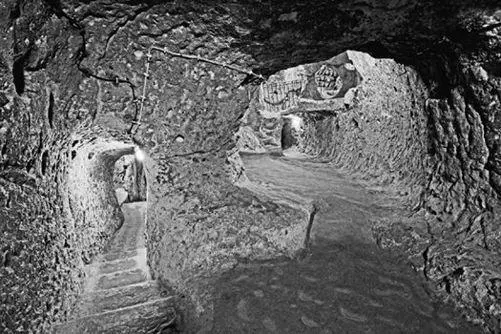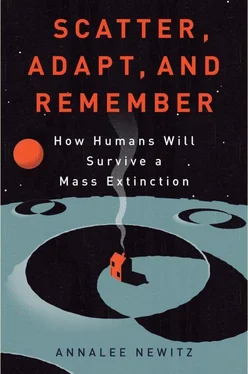
Inside the underground city of Derinkuyu, you can see two hallways leading to rooms. The city is five floors deep and housed thousands of people. (illustration credit ill.14)
Living quarters were honeycombs of interconnected rooms and bed nooks hollowed out of the tuff walls. Though the place looked barren when I saw it, a thousand years ago it would have been very different. People built wooden doors into the round doorways, covering the floors in thick carpets and the walls in draperies. Families from the city above had their own quarters below, full of furniture, favorite pottery, food, and wine. In the living areas of the city, ceilings were high and rooms were cozy rather than cramped. The underground dwellers even had a sanitation solution for long-term sojourns. Waste was packed into clay containers, sealed up, and buried in deep pits below the city’s lowest level. Large public rooms for cooking and eating, as well as wine-making and worship, would have been places where villagers could gather to make decisions about how long to remain underground and hide from danger.
This ancient city, carved out over centuries, was constantly changing and growing. A deep passage connected Derinkuyu with another underground city several kilometers away. The peoples who made these passages their refuges were employing the same survival mechanisms used by Jews over the past 2,000 years—they had scattered from distant communities in both the west and the east, and adapted themselves to the remote landscapes of central Turkey to protect themselves from persecution and ethnic cleansing. Not only did these communities survive for centuries, but they also created an entirely new way of life—one that many people in the area still enjoy today. Traditional villages in Cappadocia are full of homes built into the tuff of fairy chimneys, with narrow stairways spiraling around the rocks’ girth, leading to sturdy wooden doorways in their cone-shaped tops. Some homes are hewn from the cliffs, where they share space with countless pigeon roosts that locals tend for the fertilizer. Tourists are invited to spend the night in refurbished cave homes, as bed-and-breakfasts take over abandoned dwellings. I spent several days in one such hotel, my bed stashed deep inside a cave that had been modified to have large picture windows overlooking the city of Göreme. With the exception of the windows, my bedroom could have been torn from a future world where humans had to relocate underground for protection.
But without those windows, the place would have been much more dismal. And that’s why urban planners creating modern underground cities worry as much about the psychological effects of living underground as they do about the structural integrity of underground spaces.
If we’re going to survive a nuclear war, a meteor strike, or a radiation event, there is no doubt that we’ll have to live underground for months, or even years, as the planet recovers. In the unlikely event that a gamma-ray burst burns off the ozone layer, it could be centuries before life could thrive on the surface again—whenever we stepped outside our underground homes, we’d need to wear protective covering to shield us from the sun’s ultraviolet radiation. The good news is that three feet of packed dirt over your head can significantly reduce the intensity of radiation, and a layer of concrete can provide more safety still. We have the engineering ability to create radiation-shielded cities by going underground. The question is how we would live there.
In the event of a radiation emergency, people might find themselves having to create cities in already-existing underground spaces like subway tunnels, mines, sewer systems, and service tunnels. Already-existing underground cities like Montréal’s “RÉSO,” a 20-mile system of tunnels that connect shopping centers, metro stations, schools, apartments, and more, are basically larger and more complicated versions of mining shafts. To make the long, dark corridors more livable, developers build structures inside the bare rock walls, covering up the stone surfaces.
Making these spaces inviting is crucial to our survival. John Zacharias, a city-planning professor at Montréal’s Concordia University, has studied several underground cities, especially in Japan and China, and told me that the biggest challenge is psychological. Studies on people who work all day in underground space without any access to the outside show rising stress levels. “It’s not dramatic, but is measurable,” he said. “Going down very deep is also something people don’t like.” The new Oedo subway line in Tokyo is 55 meters below the surface, and Zacharias said people tend to avoid it in favor of an overcrowded line it was supposed to relieve. In Finland and Sweden, where underground buildings are common, studies have shown that people are disturbed by the process of descending into the Earth, and that they complain of the monotony in subterranean buildings. The solution, argue civil engineers John Carmody and Raymond Sterling in Underground Space Design , their underground-engineer omnibus, is to make sure underground spaces are “stimulating, varied environments” that give the impression of spaciousness and daylight.
Many underground cities, like RÉSO, use skylights to bring in daylight, but our future troglodytes won’t have that option because they will need radiation shielding. So they’ll have to arrange underground areas to be different sizes and shapes, with architectural features that make the space interesting to inhabit. Even the residents at Derinkuyu knew this, and their interior spaces were all uniquely arranged, with a wide variety of floor plans. Carmody and Sterling also caution that one of the main complaints people have underground is that they become disoriented without windows, so a good underground city would need a simple layout or clear signs that help inhabitants find their way. Because people get anxious about going deep underground, transitions between levels should be gradual. Ideally, different areas of the city would have dramatically different designs to give the feeling of neighborhoods and landmarks that we use aboveground to figure out where we are. Privacy will also be a premium in spaces like these, where people have a tendency to feel trapped. As we turn our tunnels into our homes, we’ll want to remember to create places to be alone, as well as vast, high-ceilinged rooms that will make us feel as if we’re outdoors even if we aren’t.
If we are turning mines into cities, or excavating a brand-new subterranean metropolis, there are also a few basic engineering issues we should keep in mind. Agust Gudmundsson, a geology professor at Royal Holloway, University of London, studies underground structures, and he explained that earthquakes will be a threat to life belowground. “Fractures that form or are reactivated during an earthquake may lead to water flowing into parts of the underground city,” he said. Water leakage is one of the main causes of destruction in these developments, and leaks recently led to partial collapse of some tunnels in RÉSO. When we build underground, Gudmundsson cautioned, we have to be vigilant about whether we’re building in regions with faults or cracks—especially if the city will be near a body of water. Just building the city could cause tremors that allow water to come seeping through cracks, causing damage or collapse over time. At the NORAD facility in Colorado, the water-leakage problem was so severe that people walked under umbrellas through the long rock tunnel that winds deep into the mountain and to the massively reinforced city gates.
Читать дальше







![Аннали Ньюиц - Автономность [litres]](/books/424681/annali-nyuic-avtonomnost-litres-thumb.webp)





